This well-known South African plant probably needs little introduction as it is cultivated in many countries across the world. I was surprised to learn that it is the floral emblem of the city of Los Angeles.
In our climate it is hardy and easy to grow, tolerating dry conditions but also coping well when the rains are good. It is nectar rich and attracts many birds. Its seeds are also popular with birds and monkeys.
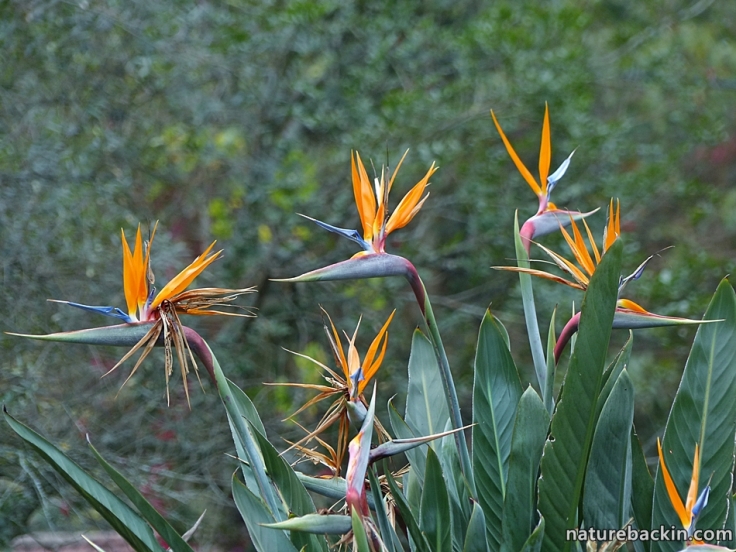
It has leaves rather like those of banana plants and grows in a clumping formation to a height of up to about 1.5 metres, depending on growing conditions
Here in South Africa it is commonly referred to simply as a Strelizia. Its full botanical name is Strelizia reginae. It is also known as the Bird-of-Paradise and as the Crane Flower.

In the photo above the birdlike shape of the Strelizia reginae , with “bill” and crown of petals can be seen clearly

Here is an actual Grey Crowned Crane, the crane that inspired the name “Crane Flower” by which the Strelizia reginae is often known. I took this photo in the Karkloof area of the KwaZulu-Natal Midlands
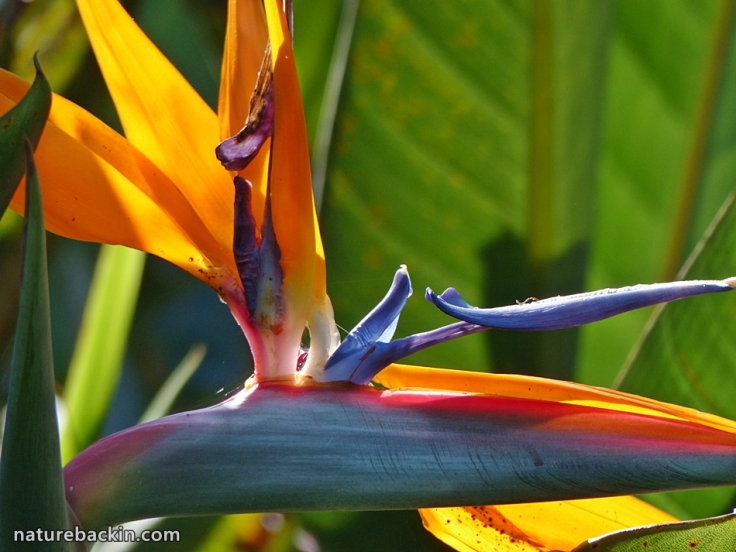
This backlit picture shows off the vibrant colours of the Strelizia reginae
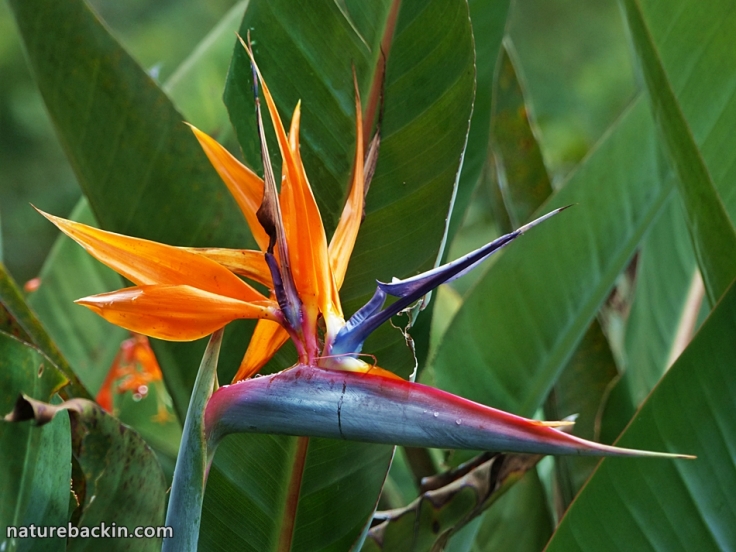
The dramatic lines of the flower of the Strelizia reginae make it popular as a cut-flower
Possibly less well known is the Strelizia nicolai, a much larger cousin, which grows to a towering height of up to 10 metres. Its palm-like appearance brings a tropical wildness to the garden. In keeping with its size its flowers are much larger than those of the Strelizia reginae, but being cream and blue they are not as colourful.

The large flowers of the Strelizia nicolai
Known also as the Coastal Strelizia or the Natal Wild Banana (although it is not related to the true banana family) the Strelizia nicolai can withstand strong, salt-laden coastal winds, but it is not frosty hardy. The nicolai part of its name is named for Czar Nicolai 1 of Russia (1796-1855). The species was described in 1858 from the plant in the Czar’s collection. The family name, Strelitziaceae, is in honour of Queen Charlotte, wife of the English King George 111 (1738-1820), as she was from the house of Mecklenburg-Streliz.
Just as its smaller relative, the Strelizia nicolai has rich nectar that attracts many birds. Its seeds, which are contained in woody capsules, are eaten by birds and monkeys. I once met a man collecting from a fallen branch, sprays of the star-shaped seed capsules as his family used them as Christmas decorations – he told me that they dried them and then painted them silver.
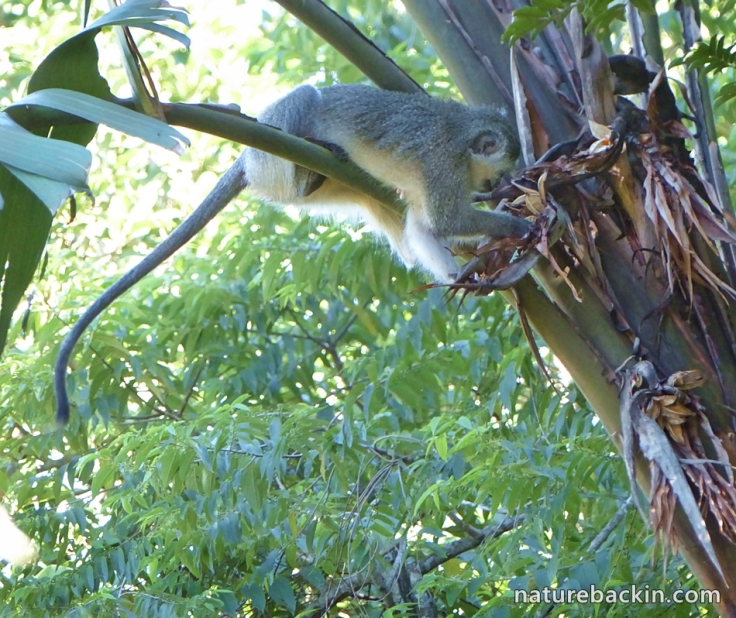
A Vervet Monkey in our garden, perching rather precariously as he extracts seeds to eat from the woody capsules on a Strelitzia nicolai
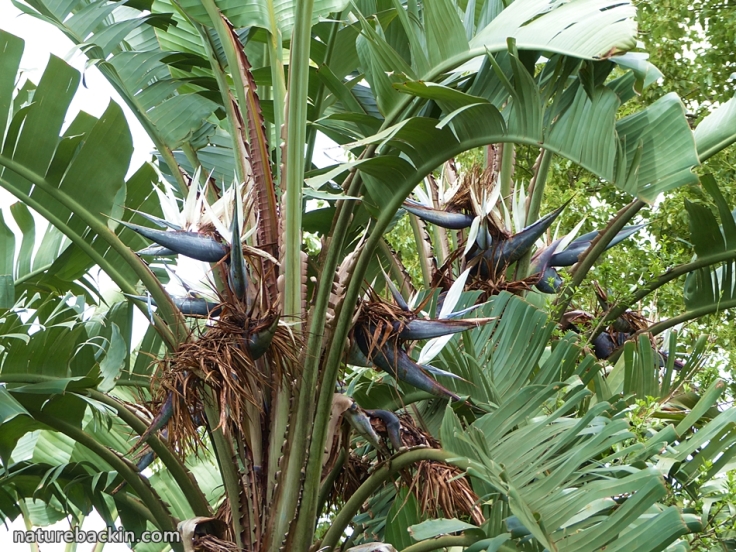
The leaves of the Strelitzia nicolai grow in impressive and graceful fan formations
Sources: Boon, Richard. 2010 (2nd ed.). Pooley’s Trees of Eastern South Africa. Durban: Flora & Fauna; Elsa Pooley. 1998. A Field Guide to Wild Flowers of KwaZulu-Natal and the Eastern Region. Durban: Natal Flora Publications Trust.
Posted by Carol









July 25, 2018 at 7:09 pm
I get so excited when I see the flora and fauna you have in your backyard: monkeys and birds of paradise! But then I recall how excited I am to hear the barred owls by the river…for the 20th time…and remember to be pleased with my own little paradise. Still..I would like to visit sometime!
LikeLiked by 1 person
July 26, 2018 at 8:34 pm
It is good and important to appreciate and value what we have on our doorsteps, but nice to travel too. Virtual travel via blogging sometimes has to suffice though, but I hope you do get to visit this part of the world.
LikeLike
June 9, 2018 at 4:43 am
Your posts are so much fun for me because they offer a peek at the very different species you enjoy. Diversity is what seems to make the world go round! 😀
LikeLiked by 1 person
June 11, 2018 at 8:18 pm
Thank you Gunta. I hope to make the time to catch up more with your posts as your part of the world looks to be so beautiful and interesting.
LikeLike
June 8, 2018 at 3:00 pm
Such a beautiful post! I find a temptation to talk to these flowers when I get them… as if they really were a bird! Great photos!
LikeLiked by 1 person
June 11, 2018 at 8:12 pm
Thanks very much. I love the idea of being tempted to talk to the birdlike flowers 🙂 Makes me smile to think about it.
LikeLike
June 8, 2018 at 1:37 pm
I have always loved the more well-known strelizia – though I’ve never been a fan of it over here. I much prefer it in warmer climes and associate it very much with SA. I’ve never seen its larger relative before; that one is huge! Without the brighter colouring, the flowers take on a slightly spectral appearance.
LikeLiked by 1 person
June 11, 2018 at 8:10 pm
I can’t really imagine strelizia’s growing in England – the have such a tropical aura. I love your description of the flowers of the larger one being slightly spectral. I found them difficult to photograph as they seem to lack definition, so spectral is an apt word.
LikeLike
June 8, 2018 at 1:28 pm
Monkeys in your garden – wow! So exotic! As are these stunning plants. I do know of them – they are popular in floral displays in chic hotels in London and Paris. I have even had them included in a bouquet on one occasion though I fail to remember who it was from or why. They are absolutely stunning and it is fascinating to read about them in your typically well constructed and informative post. The pictures, of course are amazing 😊
LikeLiked by 2 people
June 11, 2018 at 8:07 pm
I think that it is a shame that so often we undervalue what we have and place a higher value on what comes from afar or seems to be in some way unusual. After all, one person’s commonplace is another person’s exotic. I really hope to foster an interest in celebrating the so-called ordinary, because in fact it is not ordinary at all!! And even what may seem to be common can be a lot more fragile and precarious than we might think. (As Joni Mitchell noted in her song “Big Yellow Taxi”, we don’t know what we’ve got till its gone.) And thanks for your lovely compliments.
LikeLiked by 1 person
June 11, 2018 at 9:00 pm
You are a kindred soul. I so, so agree with every word. What IS the point of wasting this life wishing for something else when there is beauty and adventure all around us. Not climbing Everest or rowing the Indian Ocean adventures just what ordinary everyday life on this extraordinary and diverse planet. Bravo to you for wanting to foster that interest. I am right on board with you and am often to be heard humming ‘Big Yellow Taxi’ …. very often. As for the compliments, I only say what I mean and if they make the recipient feel good it’s a bonus.
LikeLiked by 1 person
June 12, 2018 at 5:51 am
Oh yes. We can lose so much by continuously displacing to Project Elsewhere and neglecting to even notice the here and now.
LikeLiked by 2 people
June 8, 2018 at 7:29 am
Well, I never knew they came from South Africa! Strange to think of them being equally happy in chilly old England. As far as I know, they provide no dinners for the local wildlife.
LikeLiked by 2 people
June 11, 2018 at 7:37 pm
It is surprising that they cope with such a different climate. I wonder if any English wildlife have found ways of harvesting the nectar in the flowers.
LikeLike
June 8, 2018 at 5:55 am
A fantastic looking flower! You can find them often on the Canarian Islands. Every time a highlight!
LikeLiked by 2 people
June 11, 2018 at 7:30 pm
It is a remarkable flower. I am starting to get some idea of how widespread it has become.
LikeLiked by 1 person
June 8, 2018 at 5:30 am
The notion of having a monkey in your garden is a strange one indeed, although, when I think about, no stranger than a kangaroo I suppose. The first strelitzia you posted is remarkably healthy and glossy.
LikeLiked by 1 person
June 11, 2018 at 7:28 pm
I would certainly be very surprised to find a kangaroo in my garden 🙂 But seriously, I know what you mean. Btw, I recently came across DH Lawrence’s poem about a kangaroo. It does reflect some of the notions of his time, but it does capture something essential about kangaroos. (I have seen kangaroos in other people’s gardens on a visit to Oz :))
LikeLike
June 8, 2018 at 12:35 am
A striking plant, it does have a regal bearing. Love the shot of the monkey getting a snack. 🙂
LikeLiked by 3 people
June 8, 2018 at 5:45 am
The royal connections in the plants’ names seem apt!. The monkey had to work quite hard to extract the seeds.
LikeLiked by 1 person
June 8, 2018 at 12:28 am
A favorite plants for geckos in Hawaii. It’s common to see them taking a drink from the flowers.
LikeLiked by 2 people
June 8, 2018 at 5:43 am
That is interesting. Are they drinking nectar or accumulated moisture? I have not noticed geckos doing that here. I’ll keep a look out.
LikeLike
June 9, 2018 at 9:20 pm
I think it could be either. They’ll take moisture where they can find it, but some geckos also eat nectar. Here in Hawaii, I’ve seen gold dust day geckos and mourning geckos doing that.
LikeLiked by 1 person
June 11, 2018 at 8:25 pm
Thanks Graham. I had not heard of nectar-eating geckos before.
LikeLike
June 8, 2018 at 12:06 am
Those are such stunning blooms. I always consider it a real treat to receive a flower arrangement containing Bird Of Paradise.
LikeLiked by 2 people
June 8, 2018 at 5:40 am
Thanks Sandy. Perhaps we are inclined to take them for granted here.
LikeLiked by 1 person
June 8, 2018 at 3:15 pm
Yes, I am sometimes surprised how excited those who live in large urban areas become when they experience the wide open spaces of Nebraska. It takes others’ eyes to help us see and appreciate what we have at times.
LikeLiked by 1 person
June 11, 2018 at 8:15 pm
That is so true. I can only imagine what it must be like for urban dwellers to experience for the first time the big landscapes and skies of Nebraska that I have only peeked at in your photographs.
LikeLiked by 1 person